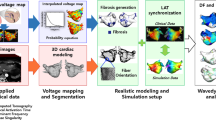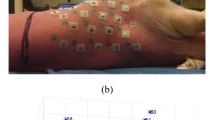Abstract
Current biophysical atrial models for investigating atrial fibrillation (AF) mechanisms and treatment approaches use imaging data to define patient-specific anatomy. Electrophysiology of the models can be calibrated using invasive electrical data collected using electroanatomic mapping (EAM) systems. However, these EAM data are typically only available after the catheter ablation procedure has begun, which makes it challenging to use personalised biophysical simulations for informing procedures. In this study, we first aimed to derive a mapping between LGE-MRI intensity and EAM conduction velocity (CV) for calibrating patient-specific left atrial electrophysiology models. Second, we investigated the functional effects of this calibration on simulated arrhythmia properties. To achieve this, we used the Universal Atrial Coordinate (UAC) system to register LGE-MRI and EAM meshes for ten patients. We then post-processed these data to investigate the relationship between LGE-MRI intensities and EAM CV. Mean atrial CV decreased from 0.81 ± 0.31 m/s to 0.58 ± 0.18 m/s as LGE-MRI image intensity ratio (IIR) increased from IIR < 0.9 to 1.6 ≤ IIR. The relationship between IIR and CV was used to calibrate conductivity for a cohort of 50 patient-specific models constructed from LGE-MRI data. This calibration increased the mean number of phase singularities during simulated arrhythmia from 2.67 ± 0.94 to 5.15 ± 2.60.
Access this chapter
Tax calculation will be finalised at checkout
Purchases are for personal use only
Similar content being viewed by others
References
Boyle, P.M., et al.: Computationally guided personalized targeted ablation of persistent atrial fibrillation. Nat. Biomed. Eng. 3, 870–879 (2019). https://doi.org/10.1038/s41551-019-0437-9
Roney, C.H., et al.: In silico comparison of left atrial ablation techniques that target the anatomical, structural, and electrical substrates of atrial fibrillation. Front. Physiol. 11 (2020). https://doi.org/10.3389/fphys.2020.572874
Lalani, G.G., Schricker, A., Gibson, M., Rostamian, A., Krummen, D.E., Narayan, S.M.: Atrial conduction slows immediately before the onset of human atrial fibrillation: a bi-atrial contact mapping study of transitions to atrial fibrillation. J. Am. Coll. Cardiol. 59, 595–606 (2012). https://doi.org/10.1016/j.jacc.2011.10.879
Corrado, C., Williams, S., Karim, R., Plank, G., O’Neill, M., Niederer, S.: A work flow to build and validate patient specific left atrium electrophysiology models from catheter measurements. Med. Image Anal. 47, 153–163 (2018). https://doi.org/10.1016/j.media.2018.04.005
Fukumoto, K., et al.: Association of left atrial local conduction velocity with late gadolinium enhancement on cardiac magnetic resonance in patients with atrial fibrillation. Circ. Arrhythmia Electrophysiol. 9, 1–7 (2016). https://doi.org/10.1161/CIRCEP.115.002897
Ali, R.L., et al.: Left atrial enhancement correlates with myocardial conduction velocity in patients with persistent atrial fibrillation. Front. Physiol. (2020). https://doi.org/10.3389/fphys.2020.570203
Caixal, G., et al.: Accuracy of left atrial fibrosis detection with cardiac magnetic resonance: correlation of late gadolinium enhancement with endocardial voltage and conduction velocity. EP Eur. 23, 380–388 (2021). https://doi.org/10.1093/europace/euaa313
Haissaguerre, M., et al.: Intermittent drivers anchoring to structural heterogeneities as a major pathophysiological mechanism of human persistent atrial fibrillation. J. Physiol. 594, 2387–2398 (2016). https://doi.org/10.1113/JP270617
Roney, C.H., et al.: Universal atrial coordinates applied to visualisation, registration and construction of patient specific meshes. Med. Image Anal. 55, 65–75 (2019). https://doi.org/10.1016/j.media.2019.04.004
Sim, I., et al.: Reproducibility of Atrial Fibrosis Assessment Using CMR Imaging and an Open Source Platform. JACC Cardiovasc. Imaging 12, 65–75 (2019). https://doi.org/10.1016/j.jcmg.2019.03.027
Sim, I., et al.: Reproducibility of atrial fibrosis assessment using CMR imaging and an open source platform. JACC Cardiovasc. Imaging 12, 2076–2077 (2019). https://doi.org/10.1016/j.jcmg.2019.03.027
Razeghi, O., et al.: CemrgApp: an interactive medical imaging application with image processing, computer vision, and machine learning toolkits for cardiovascular research. SoftwareX 12, (2020). https://doi.org/10.1016/j.softx.2020.100570
Roney, C.H., et al.: Constructing a human atrial fibre atlas. Ann. Biomed. Eng. (2020). https://doi.org/10.1007/s10439-020-02525-w
Williams, S.E., et al.: OpenEP: a cross-platform electroanatomic mapping data format and analysis platform for electrophysiology research. Front. Physiol. 88, 105–121 (2021)
Roney, C.H., et al.: An automated algorithm for determining conduction velocity, wavefront direction and origin of focal cardiac arrhythmias using a multipolar catheter. In: 2014 36th Annual International Conference of the IEEE Engineering in Medicine and Biology Society, pp 1583–1586. IEEE (2014)
Roney, C.H., et al.: A technique for measuring anisotropy in atrial conduction to estimate conduction velocity and atrial fibre direction. Comput. Biol. Med. 104, 278–290 (2019). https://doi.org/10.1016/j.compbiomed.2018.10.019
Khurram, I.M., et al.: Magnetic resonance image intensity ratio, a normalized measure to enable interpatient comparability of left atrial fibrosis. Hear Rhythm 11, 85–92 (2014). https://doi.org/10.1016/j.hrthm.2013.10.007
Courtemanche, M., Ramirez, R.J., Nattel, S.: Ionic targets for drug therapy and atrial fibrillation-induced electrical remodeling: insights from a mathematical model. Cardiovasc. Res. 42, 477–489 (1999)
Bayer, J.D., Roney, C.H., Pashaei, A., Jaïs, P., Vigmond, E.J.: Novel radiofrequency ablation strategies for terminating atrial fibrillation in the left atrium: a simulation study. Front. Physiol. 7, 108 (2016). https://doi.org/10.3389/fphys.2016.00108
Roney, C.H., et al.: A technique for measuring anisotropy in atrial conduction to estimate conduction velocity and atrial fibre direction. Comput. Biol. Med. 104, 278–290 (2019). https://doi.org/10.1016/j.compbiomed.2018.10.019
Roney, C.H., et al.: Modelling methodology of atrial fibrosis affects rotor dynamics and electrograms. Europace (2016). https://doi.org/10.1093/europace/euw365
Plank, G., et al.: The openCARP Simulation Environment for Cardiac Electrophysiology. bioRxiv, 1–22 (2021). https://doi.org/10.1101/2021.03.01.433036
Benito, E.M., et al.: Preferential regional distribution of atrial fibrosis in posterior wall around left inferior pulmonary vein as identified by late gadolinium enhancement cardiac magnetic resonance in patients with atrial fibrillation. Europace 20, 1959–1965 (2018). https://doi.org/10.1093/europace/euy095
Grandits, T., Pezzuto, S., Lubrecht, Jolijn M., Pock, T., Plank, G., Krause, R.: PIEMAP: Personalized Inverse Eikonal Model from Cardiac Electro-Anatomical Maps. In: Puyol Anton, E., Pop, M., Sermesant, M., Campello, V., Lalande, A., Lekadir, K., Suinesiaputra, A., Camara, O., Young, A. (eds.) STACOM 2020. LNCS, vol. 12592, pp. 76–86. Springer, Cham (2021). https://doi.org/10.1007/978-3-030-68107-4_8
Acknowledgement
CR is funded by an MRC Skills Development Fellowship (MR/S015086/1). SN acknowledges support from the EPSRC (EP/M012492/1, NS/A000049/1, and EP/P01268X/1), the British Heart Foundation (PG/15/91/31812, PG/13/37/30280), and Kings Health Partners London National Institute for Health Research (NIHR) Biomedical Research Centre. SW acknowledges a British Heart Foundation Fellowship (FS 20/26/34952). This work was supported by the Wellcome/EPSRC Centre for Medical Engineering (WT 203148/Z/16/Z).
Author information
Authors and Affiliations
Corresponding author
Editor information
Editors and Affiliations
Rights and permissions
Copyright information
© 2021 Springer Nature Switzerland AG
About this paper
Cite this paper
Beach, M. et al. (2021). Using the Universal Atrial Coordinate System for MRI and Electroanatomic Data Registration in Patient-Specific Left Atrial Model Construction and Simulation. In: Ennis, D.B., Perotti, L.E., Wang, V.Y. (eds) Functional Imaging and Modeling of the Heart. FIMH 2021. Lecture Notes in Computer Science(), vol 12738. Springer, Cham. https://doi.org/10.1007/978-3-030-78710-3_60
Download citation
DOI: https://doi.org/10.1007/978-3-030-78710-3_60
Published:
Publisher Name: Springer, Cham
Print ISBN: 978-3-030-78709-7
Online ISBN: 978-3-030-78710-3
eBook Packages: Computer ScienceComputer Science (R0)




